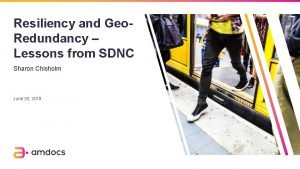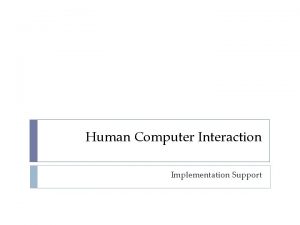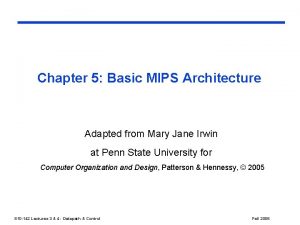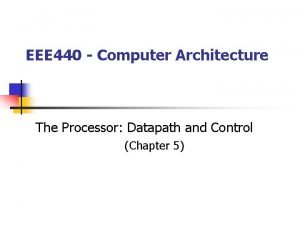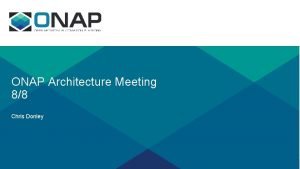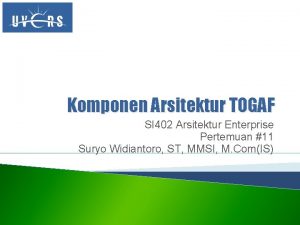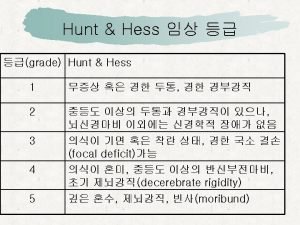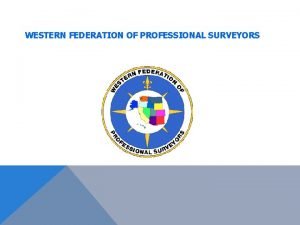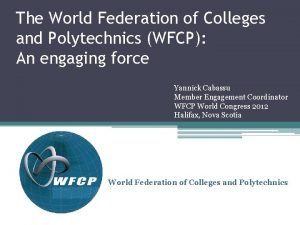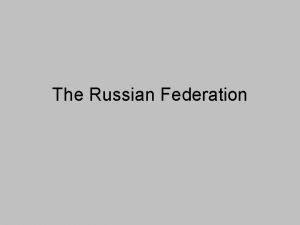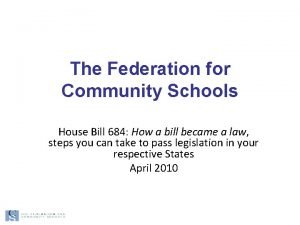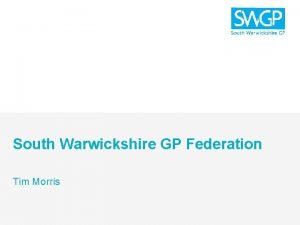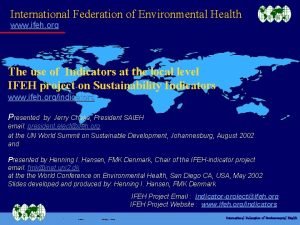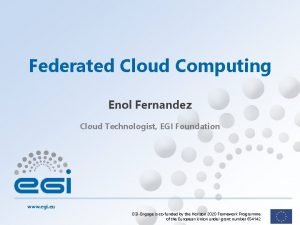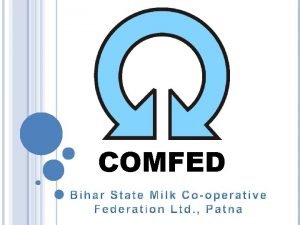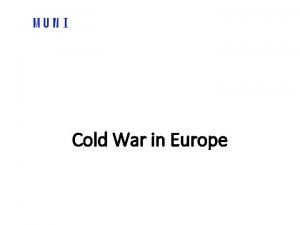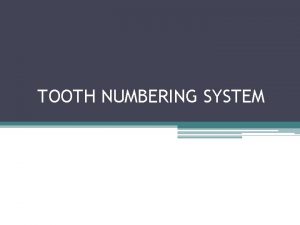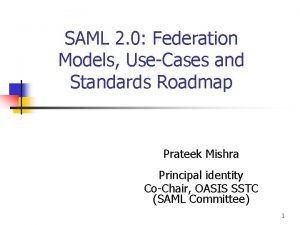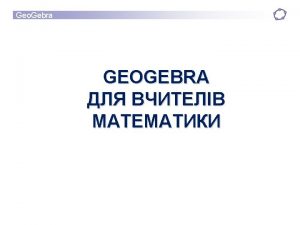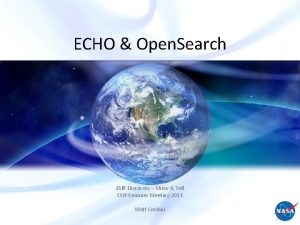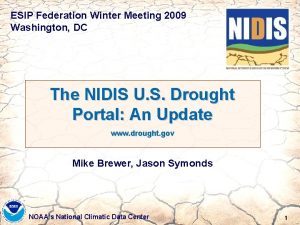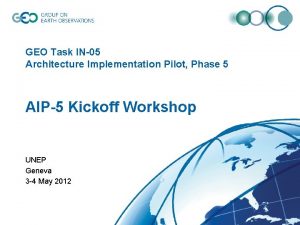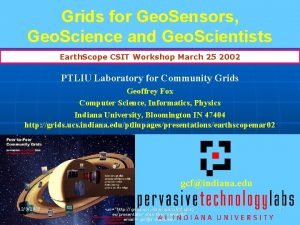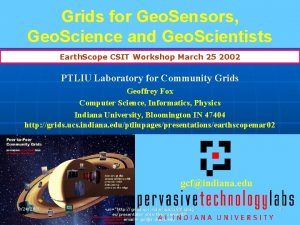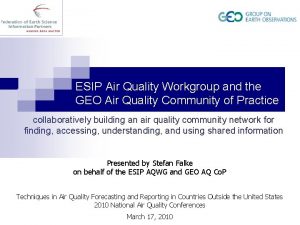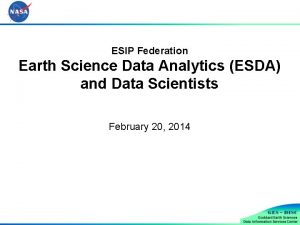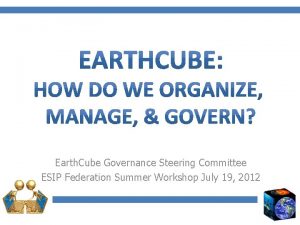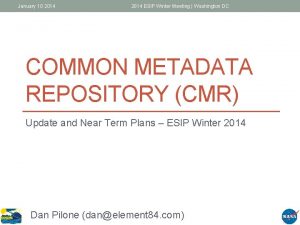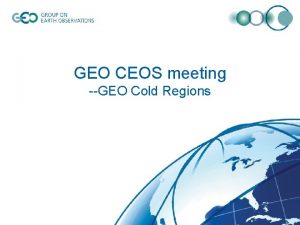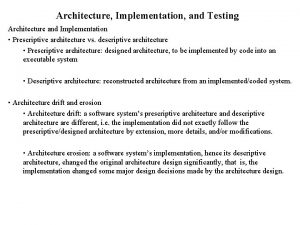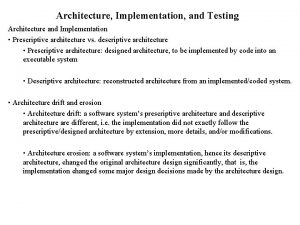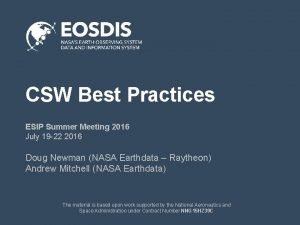GEO Architecture Implementation Pilot ESIP Federation Meeting January























- Slides: 23

GEO Architecture Implementation Pilot ESIP Federation Meeting January 2009

GEO AIP-2 Session at ESIP Federation Architecture Implementation Pilot, Phase 2 (AIP-2) • AIP Overview – George Percivall, OGC • Access Working Group – Glenn Rutledge, NOAA • Air Quality Working Group – Stefan Falke, Northrop Grumman

GEO Task AR-07 -02 Architecture Implementation Pilot George Percivall, OGC January 2009 ESIP Federation Meeting

GEOSS connects Observations to Decisions 4 4

Elaboration of GEOSS Architecture SBA Tasks, UIC User Needs, Scenarios requirements Design, Develop, Deploy support Operational Capability GEOSS Common Infrastructure (GCI) persistent implementation Architecture Implementation Pilot (AIP)

GEOSS Interoperability Arrangements - From the GEOSS 10 Year Plan Reference Document - • Interoperability through open interfaces – Interoperability specifications agreed to among contributing systems – Access to data and information through service interfaces • Open standards and intellectual property rights – GEOSS adopting standards; agreed upon by consensus, preference to formal international standards – GEOSS will not require commercial or proprietary standards – Multiple software implementations compliant with the open standards should exist – Goal is that at least one of the implementations should be available to all implementers "royalty-free"

GEO Task AR-07 -02 Architecture Implementation Pilot • Lead incorporation of contributed components consistent with the GEOSS Architecture… • …using a GEO Web Portal and a GEOSS Clearinghouse search facility • …to access services through GEOSS Interoperability Arrangements • …in support of GEOSS Societal Benefit Areas Slide 7

AIP Phase 1 results in 2007 • Demonstrated effective development process: – CFP, Kickoff, Execution, etc. – Approximately 120 organizations • Established organization communication methods – For international coordination • Produced Screencasts of Initial Operating Capability • Prepared “Architecture Implementation Report” AI Pilot has broad international participation that could only have occurred with GEO. High interest & momentum supporting GEOSS vision. Slide 8

AIP Phase 2 Themes • Augment the GEOSS Common Infrastructure • Emphasize SBAs identified by UIC/ADC collaboration • Develop "persistent exemplars” • Elaborate GEOSS Architecture – Scenarios and Use Cases – Service and Component types – Interoperability Arrangements Slide 9

AI Pilot Development Approach Participation AR-07 -02 Architecture Implementation Pilot Evolutionary Development Process Concept Development Participation Call for Participation Updates for each step Architecture Documentation Continuous interaction with external activities Participation Kick-off Workshop Participation Development Activities Baseline Operational Baseline and Lessons Learned for next evolutionary spiral Participation Persistent Operations (AR-07 -01)

AIP Phase 2 Master Schedule AIP-2 CFP Announced CFP Responses for Kickoff due Kickoff Workshop at NCAR Status to GEO Plenary 26 June 2008 1 September 2008 25 -26 September 2008 November 2008 Scenarios and Use Cases defined January 2009 Scenario demonstration capture 1 st Qtr of 2009 AIP-2 results transition to operations 1 st Half of 2009

AIP-2 CFP Responses (37 to date) • • • • ACRF BKG Caribbean Flood Team CIESIN CNES and ERDAS Compusult EPA Air. Now ERDAS Titan ESA ESIP AQ Cluster ESRI Canada Euro. Cryo. Clim • • • • GEONETCast GEO Grid GEO-Ukraine Giovanni ICAN ICT 4 EO INCOSE IP 3 ISPRA JAXA KDDI Mines Paris Tech NASA World Wind • • • NOAA/NASA GOES-R and GMU CSISS NOAA IOOS NOAA NCDC NOAA SNAAP Noblis Northrop Grumman Spot Image SURA/NIMSAT/Go. MO OS USGS VIEWS Washington University in St. Louis

AIP-2 Kickoff Workshop, September 2008 • At NCAR Mesa Laboratory, Boulder, Colorado, USA • 85 Participants • 3 Plenary Sessions • 12 Parallel Sessions based on CFP Responses • Established Working Groups; and Development Plan

AIP-2 Augmenting GCI GEOSS Common Infrastructure Main GEO Web Site Registered Community Resources Client Tier Registries GEO Web Portals Community Portals Client Applications Components & Services Standards and Interoperability Best Practices Wiki Business Process Tier GEOSS Clearinghouse User Requirements Community Catalogues Workflow Management Alert Servers Processing Servers Access Tier GEONETCast Product Access Servers Sensor Web Servers Model Access Servers

AIP-2 Working Groups (WGs) • Community WGs – Disaster Response – Climate Change and Biodiversity – Renewable Energy – Air Quality • Transverse Technology WGs: – Clearinghouse, Catalogues, Registries and Metadata – Access Services: products, sensors, models – Workflow and Alerts – Portals and Application Clients – Test Facility for service registration

Community WG Leaders • Disaster Response – Stuart Frye, NASA; – Didier Giacobbo, Spot Image • Health SBA: Air Quality – David Mc. Cabe, EPA – Frank Lindsay, NASA; – Stefan Falke & Rudy Husar, Washington Univ. • Biodiversity and Climate Change – Stefano Nativi, CNR; – Gary Geller, NASA/JPL • Energy SBA – Thierry Ranchin & Lionel Menard, Mines Paris Tech; – Ellsworth Le. Drew, Univ Waterloo;

Transverse Technology WG Leaders • • • Catalogues, Clearinghouse, Registries and Metadata – Doug Nebert, USGS; – Ted Haberman, NOAA – Kengo Aizawa, JAXA; – Josh Lieberman OGC/Traverse; Workflow and Alerts – Satoshi Sekiguchi, AIST; – Eugene Yu, GMU; – Greg Yetman, CIESIN Test Facility for service registration – Mauro Semerano, ESA • • Portals and application clients – Nadine Alameh, OGC/Mobile. Aps; – Herve' Caumont, OGC/ERDAS Access Services: products, sensors, models – Glenn Rutledge NOAA, – Herve' Caumont, OGC/ERDAS; – Hans Peter Plag, UNR; – Anwar Vahed, ICT 4 EO; – Luis Bermudez SURA;

Scenarios and Use Cases • Transverse Use Cases support Community Scenarios • Scenarios: end user view of the value of GEOSS – – Focused on topics of interest to a community Occur in a geographic Area of Interest (AOI) Steps in a scenario are Use Cases Scenarios developed by Community WGs • Use Cases: reusable service oriented architecture – Use cases for discovery, data access, etc – Utilize Interoperability Arrangements – Use Cases developed by Transverse Technology WGs

Community Scenarios - Draft • Air Quality and Health: – Use of earth observations to inform three decision-makers: policy-maker, AQ compliance manager, and the public • Disasters: – Disaster cycle for Flooding events • Biodiversity and Climate Change – Polar scenario(s) – CC impact on Pikas in North America; • Renewable Energy – Site selection process for solar and wind energy

Transverse Technology Use Cases - DRAFT 01 Register Resources CCRM 02 Deploy Components and Services Access 03 Publish, Harvest, and Query Metadata via Clearinghouse CCRM 04 Client Search of Metadata Portal / Client 05 Client Management of Services and Alerts Portal / Client 06 Interact with Services Access 07 Exploit Data Visually and Analytically Portal / Client 08 Construct and Deploy Workflow 09 Test services Testing 10 Register New Interoperability Arrangements CCRM

AIP-2 Deliverables - 2009 • • • Demonstration – Demonstration of community Scenarios implemented through transverse Use Cases – Demonstrations to be recorded and made available via WWW. Engineering Reports To be considered for GEOSS Best Practice Registry – Community of Practice Scenarios, – Transverse Technology Use Cases – AIP-2 Summary Report Persistent Exemplars – Registered services (‘continuous operation’) with 99% availability (~7 hours down time a month); on a reliable network; plan for performance scaling – Nomination to operational task (AR-09 -01 a)

References • GEO – earthobservations. org George Percivall percivall@myogc. org • GEO Architecture Implementation Pilot – www. ogcnetwork. net/AIpilot • GEOSS registries and SIF – geossregistries. info

GEO AIP-2 Session at ESIP Federation Architecture Implementation Pilot, Phase 2 (AIP-2) • AIP Overview – George Percivall, OGC • Access Working Group – Glenn Rutledge, NOAA • Air Quality Working Group – Stefan Falke, Northrop Grumman
 Geo-redundant architecture
Geo-redundant architecture For todays meeting
For todays meeting Meeting objective
Meeting objective What is meeting and types of meeting
What is meeting and types of meeting Types of meeting
Types of meeting Programming toolkits in hci
Programming toolkits in hci Basic mips implementation in computer architecture
Basic mips implementation in computer architecture Datapath in computer architecture
Datapath in computer architecture Architecture meeting agenda
Architecture meeting agenda Architecture meeting agenda
Architecture meeting agenda Elemen togaf core metamodel
Elemen togaf core metamodel Wfns score
Wfns score Western federation of professional surveyors
Western federation of professional surveyors World federation of colleges and polytechnics
World federation of colleges and polytechnics Eurasia time zone
Eurasia time zone Am i at school
Am i at school South warwickshire gp federation
South warwickshire gp federation International federation of environmental health
International federation of environmental health Cloud federation stack
Cloud federation stack Comfed
Comfed Prague spring
Prague spring Acf certification requirements
Acf certification requirements Tooth numbering system
Tooth numbering system Federation models
Federation models
